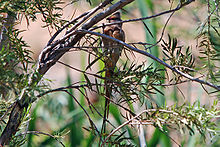Red-faced mousebird
This article includes a list of general references, but it remains largely unverified because it lacks sufficient corresponding inline citations. (December 2011) |
| Red-faced mousebird | |
|---|---|

| |
| Scientific classification | |
| Kingdom: | Animalia |
| Phylum: | Chordata |
| Class: | Aves |
| Order: | Coliiformes |
| Family: | Coliidae |
| Genus: | Urocolius |
| Species: | U. indicus
|
| Binomial name | |
| Urocolius indicus (Latham, 1790)
| |


The red-faced mousebird (Urocolius indicus) is a species of mousebird or coly. It is a common in southern Africa from Zaire, Zambia and Tanzania south to the Cape. Its habitat is savanna with thickets, fynbos scrub, other open woodland, gardens and orchards.[2]
This bird is about 34 cm (13 inches) long, with the tail comprising approximately half the length.[2] The crested head and breast are pale cinnamon with a red bill and eye mask. The rest of the upperparts and tail are blue-grey apart from a paler grey rump. The belly is whitish. The sexes are similar, but juveniles lack the crest and have a green mask. Their call is tree-ree-ree whistle, and regularly called in multiple repetitions.[2] Red-faced mousebirds make the same call whether in-flight or perched.[2]
The red-faced mousebird is a frugivore which subsists on fruits, berries, leaves, seeds and nectar.[2] Its flight is typically fast, strong and direct from one feeding area to another.
This is a social bird outside the breeding season, feeding together in small groups, normally of about half a dozen birds, but sometimes up to 15 or more. They fly and interact in tight collections.[2] It engages in mutual preening and roosts in groups at night. It is more wary than other mousebirds.
These sedentary birds breed between June to February. The nest is a large untidy cup of plant material lined with material such as sheep wool. The clutch is 2-6 eggs which hatch in about two weeks.
References[]
- ^ BirdLife International (2016). "Urocolius indicus". IUCN Red List of Threatened Species. 2016: e.T22683796A95211592. doi:10.2305/IUCN.UK.2016-3.RLTS.T22683796A95211592.en. Retrieved 12 November 2021.
- ^ a b c d e f Newman, Vanessa (2010). Newman's Birds of Southern Africa. Cape Town, South Africa: Pippa Parker. p. 274. ISBN 9781770078765.
| Wikimedia Commons has media related to Urocolius indicus. |
- Ian Sinclair, Phil Hockey and Warwick Tarboton, SASOL Birds of Southern Africa (Struik 2002) ISBN 1-86872-721-1
External links[]
- Red-faced mousebird - Species text in The Atlas of Southern African Birds.
- IUCN Red List least concern species
- Urocolius
- Birds of Southern Africa
- Birds described in 1790
